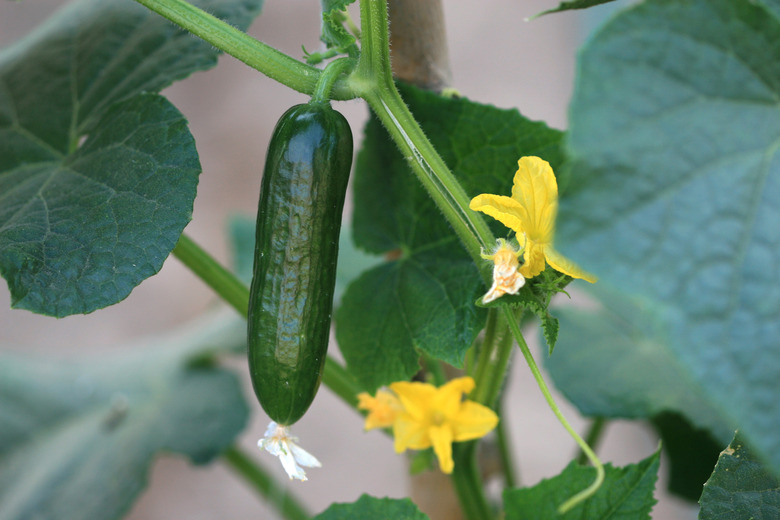What Is The Best Fertilizer For Cucumbers?
We may receive a commission on purchases made from links.
Cucumbers (Cucumis sativus) belong to the gourd family (Cucurbitaceae), along with pumpkins (Cucurbita maxima), squash and gourds (both Cucurbita pepo). Popular annual vines grown throughout the United States, cucumbers produce best during long, warm summer days. Standard cucumber vines grow rapidly and need vertical support. Dwarf bush cucumbers support themselves, and these compact plants grow well in small garden plots or containers.
No matter the type of cucumber vine you plant when growing cucumbers, organic soil amendments meet their special nutrient requirements best.
Tip
Cucumbers require fertilizer that is low in nitrogen and high in potassium and phosphorus.
Cucumber Nutrient Requirements
Cucumber Nutrient Requirements
Cucumbers have low nitrogen requirements, but they need high potassium and high phosphorus levels. With commercial fertilizer formulas, this means the first of the three numbers on the package should be lower, for instance, 5-10-10. Or the numbers overall should be low, such as 4-4-4, rather than 20-20-20.
Knowing your soil type helps determine how much and what nutrients your cucumbers need. Sandy soils leach vital substances and become nutrient-poor quickly. Heavy soils can lock up nutrients. Adding compost before planting improves most garden soil. The organic matter enriches light sandy soils and lightens heavy clay soils.
Nitrogen Precautions When Feeding Cucumbers
Nitrogen Precautions When Feeding Cucumbers
Beware of overfeeding your cucumbers with general, all-purpose formulas that contain high nitrogen levels. For instance, packages that read 20-20-20 or 30-30-30. They may encourage growth, but not the way you want.
Since cucumbers have low nitrogen requirements, fertilizers high in nitrogen spark growth spurts that detract from the fruit. Instead of producing blossoms and fruit, nitrogen-fed cucumbers put their energy into growing vines, leaves and shoots. High-nitrogen fertilizers can also cause cucumber flowers to not open, which will result in no fruit. You can find low nitrogen fertilizers at Amazon, Home Depot and Walmart.
Well-Aged Compost for Cucumbers
Well-Aged Compost for Cucumbers
The best cucumber fertilizer is well-aged compost. Compost only has 2 percent nitrogen, and it releases slowly over many years. Compost won't cause runaway vegetative growth at the expense of fruit. Instead, it adds nutrient reserves that stay available in the soil long term. Compost offers other benefits, including improving soil quality by loosening it, promoting aeration, improving drainage, and boosting disease resistance.
Compost can be applied yearly as mulch or worked into your soil prior to planting without causing excess nutrient buildup. This healthy soil amendment also supplies phosphorus, potassium and micronutrients that cucumbers need. Compost mulch also helps keep down competition from weeds, so cucumbers get soil nutrients.
You can make your own compost or buy commercially bagged compost or bulk compost at most garden centers and nurseries. Work the compost into the soil a month prior to planting.
Growing Cucumbers in Containers
Growing Cucumbers in Containers
Fertilize container grown cucumbers by mixing compost with your potting soil. You can also add a timed-released, low-nitrogen, high-potassium pelleted fertilizer with a N-P-K ratio similar to 2-3-6. Apply 1 tablespoon per pot at planting, or according to label directions if they differ from this rate, and again when you see the first true leaves on your cucumbers. For large containers over 12 inches in diameter or multiple plants in one pot, increase the amount accordingly.
After cucumbers show true leaves, apply water-soluble, low-nitrogen, high-potassium fertilizer weekly. Apply weekly fertilizers at half strength, mixing 1/2 tablespoon of fertilizer with 1 gallon of water, or according to specific label directions. Always wear gloves and protective eyewear when working with fertilizers.
